

How To Build Positive Marketing Stories That Work. Throughout human history, the stories that have survived and been passed from mind to mind have been based on human beings’ higher values.

Great Management Boils Down to One Major Thing. How Your Expectations Shape Reality. A story is told of a young psychology student serving in the Army who one day decided to test a theory. Stowe Boyd. Optimize Your Humans, Optimize Your Business. Popular Today in Business: All Popular Articles My personal quest to understand and articulate the facets of socially-enabled business has been nearly as changing as the shift itself.
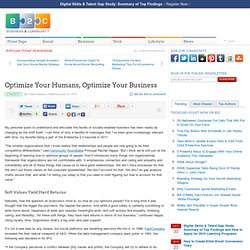
I can think of only a handful of messages that I’ve seen grow increasingly relevant with time, my favorite being a part of the Enterprise 2.0 keynote in 2011: “The smarter organizations that I know realize that relationships and people are now going to be their competitive differentiator,” said Community Roundtable Principal Rachel Happe. ”But I think we’re still just at the beginning of learning how to optimize groups of people. And it introduces many things into organizational framework that organizations are not comfortable with. It emphasizes connection and caring and empathy and vulnerability and all of these things that cause us to have good relationships.
Soft Values Yield Hard Returns. Communication Matrix. Difference Between Efficiency and Effectiveness. Efficiency and effectiveness are both commonly used management terms.

Yet, while they sound similar and start with the same letters, they both mean different things. Efficiency refers to doing things in a right manner. Scientifically, it is defined as the output to input ratio and focuses on getting the maximum output with minimum resources. Effectiveness, on the other hand, refers to doing the right things. It constantly measures if the actual output meets the desired output. Efficiency is concerned with the present state or the ‘status quo’. Effectiveness vs Efficiency. Hijacking Emotion Is The Key To Engaging Your Audience. The default to emotion is part of the human condition.

To better appreciate the role of emotion and what it allows an audience to do, we need to take a brief detour into evolutionary biology. The human brain can be understood as three separate brains working in tandem, if not completely integrated with each other. The primitive brain and the limbic brain collectively make up the limbic system, which governs emotion. Within the limbic system, there is a structure called the amygdala, which leaders need to understand.
When faced with a stimulus, the amygdala turns our emotions on. The amygdala is the key to understanding an audience’s emotional response, and to connecting with an audience. The Trouble with Gerrold: Artificial stupidity. (Page 1 of 3)Recently, I got sucked into a discussion of sentience and whether or not such a condition could be achieved in silicon.
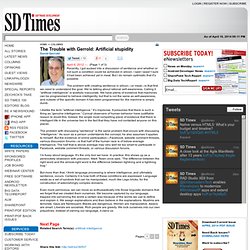
I said I wasn’t sure it had been achieved yet in meat. But I do remain optimistic that it’s possible. The problem with creating sentience in silicon—or meat—is that first we need to understand the goal. We’re talking about rational self-awareness. Calling it “artificial intelligence” is woefully inaccurate. I dislike the term “artificial intelligence.” The problem with discussing “sentience” is the same problem that occurs with discussing “intelligence.” 6 Keys For Turning Your Company Into A Design Powerhouse. While design has always been fundamental to industries such as fashion and consumer electronics, it has now spread to nontraditional settings such as airlines, consumer goods, and even governments, where it has become the driver for differentiated end-to-end customer experiences as well as innovation.
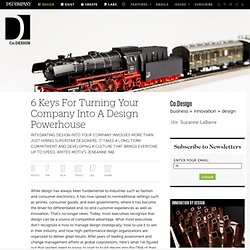
That’s no longer news: Today, most executives recognize that design can be a source of competitive advantage. What most executives don’t recognize is how to manage design strategically, how to use it to win in their industry, and how high-performance design organizations are organized to deliver great results. After years of leading assessment and change management efforts at global corporations, here’s what I’ve figured out that leaders need to know to start to build design into the DNA of their organizations. Align goals and strategy. The most effective design organizations set goals that are aligned with their organization’s corporate strategy. 6 Ways Successful People Stand Out. Bosses spend the vast majority of their time helping other people succeed: employees, customers, vendors and suppliers... the list goes on and on.
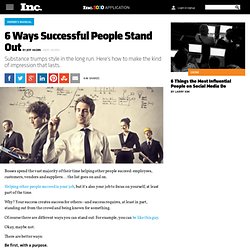
Helping other people succeed is your job, but it's also your job to focus on yourself, at least part of the time. Why? Your success creates success for others--and success requires, at least in part, standing out from the crowd and being known for something. Do You Have to Be Rude to Manage Like Steve Jobs? Harvard Business Review Over the years there have been questions about the management style of Steven P.

Jobs, co-founder of Apple. Many have asked if Mr. Jonathan Ive on Apple Product Design. It's not often that Apple head designer Jonathan Ive gives an interview.

Not only does Apple have its secretive culture, but he is reportedly a private person. However, give an interview Ive did to the London Evening Standard recently, and it's full of lessons for entrepreneurs who want to take markets by storm with great products. Do Something Well, not Different Many companies focus on differentiating themselves from the competition.
5 ideas for improving how you manage people. Managing people well requires two fundamental skills sets. Cognitive Skills at 45: Middle-Aged Brain More Resilient. A study in the British Medical Journal lit up the Internet last week with the conclusion that cognitive decline begins at age 45.
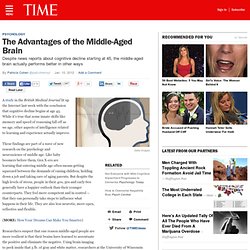
While it’s true that some innate skills like memory and speed of reasoning fall off as we age, other aspects of intelligence related to learning and experience actually improve. These findings are part of a wave of new research on the psychology and neuroscience of middle age. Like baby boomers before them, Gen X-ers are learning that entering middle age often means getting squeezed between the demands of raising children, holding down a job and taking care of aging parents. "Liars and Outliers" by Bruce Schneier - Personal-tech/science-tech - Science and Technology - BYTE.
Society runs on trust and would collapse without it. The interconnectedness of the modern world creates new and dangerous risks to trust. Bruce Schneier's recent book Liars and Outliers is a philosophical exploration of the role of trust in society, and is likely to appeal more to policy makers and academics than to information security practitioners. He describes how theories regarding trust (and perhaps trust itself) have evolved over time and sets this within the context of today's global interconnected society.
Schneier has done a very careful literature review, citing theories and experiments across multiple disciplines such as sociology, anthropology, and psychology. ScienceDirect - Home. Kurzweil Accelerating Intelligence. Emotus Ponens. Law of comparative judgment. Background[edit] Grassroots Journalism and Consumer Culture - Information Overload Is Real. Evolution and Innovation. PechaKucha Presentations. You Can't Innovate Like Apple. Practical Training. Proven Results. Alumni Resource Center Login 1-800-816-7861 You Can't Innovate Like Apple By Alain Breillatt. The Short and Sweet Guide to Being Fucking Awesome. Sera Beak-Redvolution-The Red Book-Spiritual Cowgirl. Workshops, Talks, Mentorships and Weddings.
Innovation is Not ‘Best Practice’ Taking Innovation Seriously.